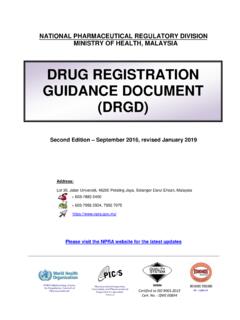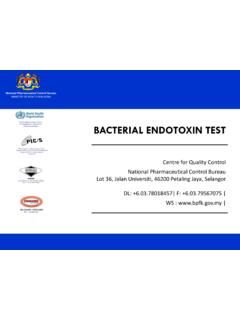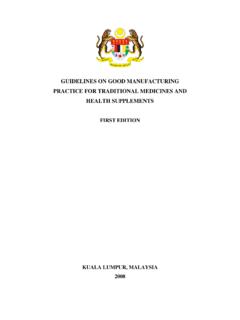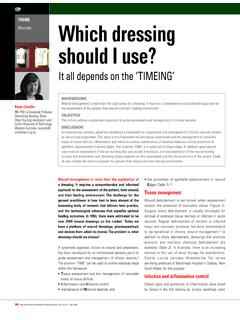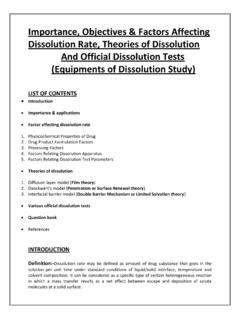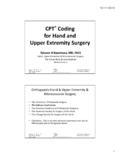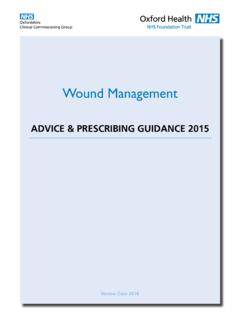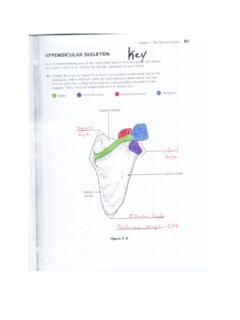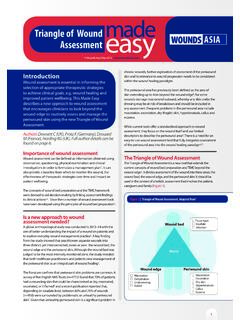Transcription of GUIDELINE FOR STABILITY DATA
1 GUIDELINE FOR STABILITY DATA The purpose of STABILITY testing is to provide evidence on how the quality of a product, in its proposed marketing packaging, varies with time under the influence of a variety of environmental factors, such as temperature, humidity and light, and enables recommended storage conditions and shelf lives to be established. 1. Size and number of batches tested The overall quality of the product batches of the formulation used in STABILITY testing should be representative of the quality of the formulation to be made on a production scale. STABILITY data from 2 current batches (preferably pilot and/ or production scale) is considered by the DCA to be the statistical minimum necessary to establish a shelf life for a product.
2 Therefore when data from less than the minimum two batches are provided the applicant should include a valid scientific argument justifying the suitability of the data provided for establishing the proposed shelf life. The batch identity, date of manufacture and batch size should be reported with the STABILITY data. 2. Containers The product should be packaged in the same containers (materials and size) that are proposed for the marketing of the final product. If the product will be marketed in containers of differing materials, then all proposed containers should be trialled. If the product is to be marketed in containers in which STABILITY testing would be impractical ( , too large), then STABILITY trials in smaller containers of the same materials and construction may be used to extrapolate to the larger containers.
3 3. Bracketing Bracketing design may be used if the product strengths are very closely related in composition, such as, 1. a tablet range made with different compression weights of a similar basic granulation , or 2. a capsule range made by filling different plug fill weights of the same basic composition into different size capsule shells, or 3. bottles containing 100 tablets and bottles containing 1000 tablets, or 4. bottles containing 100 mL of a product and bottles containing 500 mL of the product. Bracketing can be applied to different container sizes or different fills in the same container closure system. For example, where the same strength and exact container/ closure system is used for three or more fill contents, the manufacturer may elect to place only the smallest and largest container closure system into the STABILITY program.
4 An example of bracketing design is given in the table below: Table 1-1 Bracketing design 4. Storage condition Storage STABILITY programmes should include real time studies or a combination of real time and accelerated conditions. Recommended storage conditions from the labelling of Veterinary Products are listed below: Store below 18 C (deep freeze); Store below 5 C (freeze); Store between 2 C and 8 C (refrigerate. Do not freeze); Store below 8 C (refrigerate); Store below 25 C (air conditioning); Store below 30 C (room temperature). The temperature at which samples are stored at ( , real time and/ or accelerated conditions) will impact on how the STABILITY data are interpreted and the length of shelf life that can be recommended. Recommended storage conditions are as follows: Table 1-2 Recommended storage conditions (temperatures and relative humidities) Proposed storage temperature (product label) Real time testing (Minimum 2 batches) Accelerated testing (Minimum 2 batches) Products intended for Storage in a freezer -20 C 5 C Accelerated trial probably not appropriate Products intended for Storage in a refrigerator 5 C 3 C 25 C 2 C and 60% RH 5% RH 25 C (air conditioning) 25 C 2 C and 60% RH 5% RH 35 40 C 2 C and 75% RH 5% RH 30 C (room temperature) 30 C 2 C and 75% RH 40 45 C 2 C and 75% RH Strength 50 mg 75 mg 100 mg Batch 1 2 3 1 2 3 1 2 3 Container size 100 mL 250 mL 500 mL 5% RH 5% RH 5.
5 Testing intervals Samples should be tested as soon as practicable following manufacture, and then every 3 months over the first year, every 6 months over the second year and at 12-month intervals thereafter. The dates of product testing should be recorded and reported with the STABILITY data. 6. Test parameters The STABILITY study should cover those features susceptible to change during storage and likely to influence the quality, safety and efficacy of the product. Test parameters to be measured in a STABILITY trial are determined by the dosage form/ formulation type and may include: Physical properties of the product; Organolepticproperties (taste, odour, etc.); Active ingredient content and formation of toxic degradation products; The content of other important components of the formulation ( , antimicrobial preservatives); Microbial properties (where appropriate); and Relevant test parameters for each type of dosage form are given in Attachment C.
6 It is expected that all relevant parameters will be addressed in a STABILITY trial. If certain parameters are not addressed relevant scientific argument should be provided as to why testing was not required. 7. Expiry specification An expiry specification is the combination of physical, chemical, biological and microbiological test requirements that a veterinary chemical product must meet throughout its shelf life. The range of values that each test parameter must fall within throughout the shelf life of the product should be provided. These are often referred to as check specifications or expiry specifications . 8. Duration of STABILITY trials (i) Locally manufactured product At point of submission, 3 months accelerated data (45-50 C/75% RH 5% RH) or 6 months accelerated data (40 C/75% RH 5% RH)and a commitment letter to submit real time STABILITY data once available is required to claim for 3 years shelf life.
7 (ii) Imported product A minimum of 12 months realtime STABILITY data with a complete accelerated data are required during submission to claim for 2 years shelf life. 9. Testing requirements for specific veterinary chemical product types (i) Controlled-release dosage forms In addition to the specific STABILITY tests that are required for the particular dosage form, the STABILITY study should include the dissolution test to determine the rate of release of the active substance. (ii) Intramammary products Intramammary products are solutions, emulsions, suspensions or semi-solid preparations containing one or more active substances in a suitable vehicle. In addition to the parameters relevant to particular dosage forms, a test for sterility must be performed.
8 (iii) Oral drenches Drenches for oral administration are available as powders or concentrated solutions or suspensions. They are also available as solutions or suspensions ready for use. Parameters relevant to particular dosage forms should be monitored in the STABILITY study. (iv) Veterinary liquid products for cutaneous applications Veterinary liquid products for cutaneous applications are liquid preparations intended to be applied to the skin to obtain a local and/ or a systemic effect. Veterinary liquid products for cutaneous applications include dip concentrates, pour-on, spot-on, sprays, teat dips, teat sprays and udder-washers. These preparations may be supplied as concentrates or ready-to-use products. They are solutions, emulsions or suspensions containing one or more active substance in a suitable vehicle.
9 In addition to the parameters relevant to particular dosage forms, STABILITY data on diluted dipping/ jetting and teat sprays products are required. 10. Additional Tests i) Parenteral products (a) STABILITY of reconstituted products The in-use STABILITY of parenteral veterinary products that are reconstituted prior to administration, or diluted prior to use, or claimed to be stable when mixed with other products, or where the product may be labile once the container is opened, must be demonstrated, Note: the in-use STABILITY data for reconstituted products and for parenteral products supplied in multi-dose containers is not required if the product label contains a disposal statement to the effect To avoid microbial contamination, unused portions of the product must be discarded within 24 hours after reconstitution or first broaching of the container.
10 (b) In-use STABILITY testing The in-use STABILITY test should be designed to simulate the use of the product in practice. The product should be stored as recommended on the product label throughout the duration of the test. A storage condition recommendation for the product after first use may be specified on the label that is different to the unopened container storage conditions. ii) Sterile eye and ear preparations in multiple dose containers For sterile eye and ear preparations packaged in multi-dose containers, in-use (broached container) testing is required if the product is not used within four weeks after opening the container. Note: the in-use testing is not required if the product label states that the product be used within 4 weeks of opening the container. iii) Sterility requirements for product stated to be sterile Sterility should be considered as part of the shelf life of a veterinary chemical product stated to be sterile.
